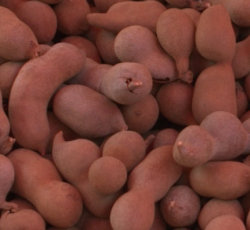Tamarind
Starting in November here in Thailand, the thick brown seed pods of the tamarind tree will begin to appear in the markets. The initial stock usually comes from Petchabun, a province just a few hours’ drive south of Chiang Mai, at the edge between northern and central Thailand. These will be packed in bags or even ‘gift’ boxes. As the season progresses, the many orchards further north around Chiang Mai will ripen and make their way to the markets. Eventually, by February or so, the crop will be so plentiful that pick-up trucks full of tamarind seeds will travel the streets and park in residential areas selling the seed pods for just a few cents a kilogram.

The ‘fruit’ of the tamarind tree is in the form of pods three to five inches long and slightly larger around than your finger. A single tree can produce 150 to 250 kilograms of pods each year. When fully ripe, the pods will be light green in color with a slightly velvety skin. They are then allowed to dry in the sun until the shell turns the color of milk chocolate. Like pea pods, the outer skin is easily split open to reveal several hard seeds surrounded by a sticky pulp. The pulp, and hopefully not too many seeds, is pressed together to form a paste that is purchased in markets for use in cooking many Thai dishes.
The tamarind tree originated in East Africa. It was spread east by traders to India and South-East Asia, where it has become an integral ingredient due to its sweet and sour taste. The trees can grow to be quite large, with feathery leaves similar to the decorative mimosa tree. Like the mimosa, the leaves will fold up at night.
The Ramayana, an epic fable on which much of Thai classical art is based, contains a passage explaining how the tamarind leaves got their serrated shape. The story surrounds an odyssey of Rama, the king of Ayodhya (a mythical kingdom that Thais incarnated in the old Siamese capital of Ayutthaya). At one point in the story, Rama is exiled in the forest. One of Rama’s generals, Laxmana, builds the king a hut using large, thick tamarind leaves. The leaves were so effective that not a drop of rain or ray of sunlight was able to enter the hut. Rama’s wife Sita was quite happy with the result, but the king was not. “Living in the forest means facing the elements and not sheltering from them. That is what vanavaas really means. We are too secure. Too comfortably protected.” The king protested.
Laxmana laughed and said, “There is no need to remove the leaves.” He then shot his arrows through the leaves until they were shredded and sunlight streamed in. Since then, tamarind leaves have been serrated, or so the legend goes.
Tamarind contains a fair amount of potassium and phosphorous. It is one of the main ingredients in Worcestershire sauce, which can be used as a substitute for tamarind juice in some recipes. Curiously, tamarind has also been recommended as a polish for brass and copper.
The word tamarind is derived from the Arab name for the tree, which translates to “Indian date.” Oddly, although the tree originated in Africa, it was sent from India to Cairo, then on to Alexandria and into Europe.
Substitutes for Tamarind Paste
Tamarind paste can be hard to come by outside of Thailand. If you just can’t find it at all, you can try running some golden raisins through a food processor. The result is very close in texture and just a bit sweeter than the real thing.